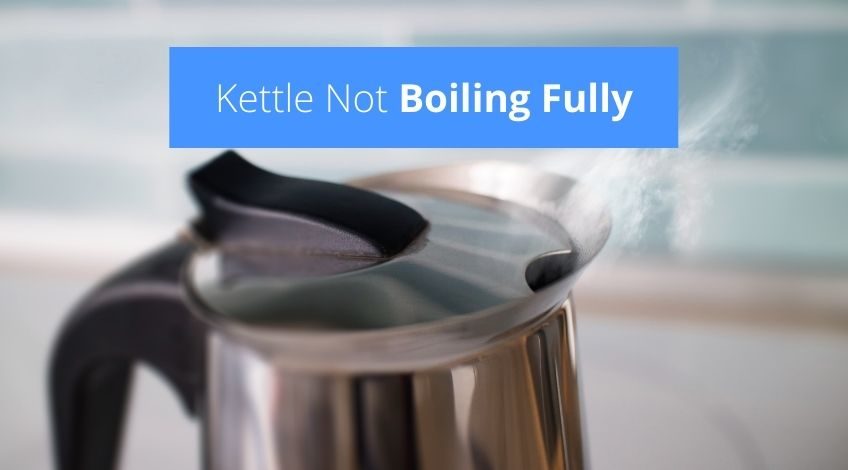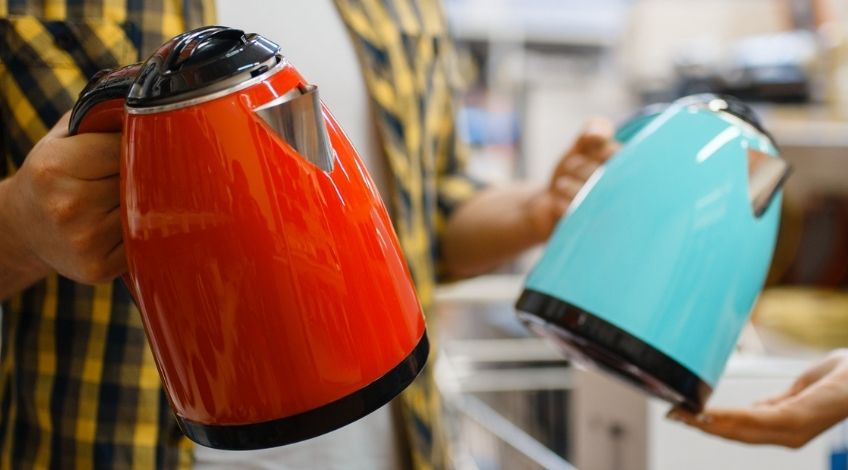
Kettle Not Boiling Fully? (this might be why)
Where would we be without our kitchen appliances? And in particular, where would we be without our kettle? We all take our electric kettles for granted, we just fill them with water, switch them on and forget about them until we pour the boiling hot water into our tea or coffee cup.
That probably describes 90% of the adult population of the UK, maybe more than 90%. So it can seem like a really devastating problem if the kettle malfunctions in some way. If your kettle isn’t boiling fully, keep reading.
Why Is The Electric Kettle Not Fully Boiling?
There are a number of reasons for the electric kettle to stop boiling before it reaches boiling point, and you’ll find them below. But to answer this question fully we need to explain exactly how an electric kettle works. So here goes in layman’s terms.
How Does The Electric Kettle Work?
All electrical appliances that need to create heat work by the principle of resistance. In the case of the electric kettle, an electric current is passed through a metal plate. The metal resists the current which creates heat which in turn boils the water. Now depending on the altitude you live at, water boils at different temperatures.
At sea level, water boils at 100 C (212 F) move one mile above sea level and it boils at 94 C (202 F). Now, kettles aren’t altitude specific which means they’re not controlled by a thermometer or any temperature control device.
What Causes An Electric Kettle To Shut Off Power?
Electric kettles aren’t controlled by internal control boards, there’s no Artificial Intelligence detecting when the water boils. No, it’s far simpler than that, simpler, but ingenious. There is a bimetallic strip which is basically two different types of metal with different expansion rates bonded together. One expands quicker when subjected to heat than the other one.
Meanwhile steam created as the water heats (due to the resistance of the metal element) runs down a channel situated inside the handle of the kettle and passes over the bimetallic strip. The heat causes the bimetallic strip to change shape (curve in the opposite direction) as it snaps into this shape it flicks a switch to break the electrical circuit and cut the power.
As the bimetallic strip cools down it reverts to its original shape and the kettle is ready to use again. That’s the simplified process of how an electric kettle produces water at exactly boiling point at whatever altitude you live at.
Why Is The Kettle Not Boiling Fully?
If your kettle turns off before reaching boiling point it can usually be determined to have been caused by a few things, either;
- The Bimetallic Plate Has Become Defective
- Limescale Build-Up
- Broken Thermostat
- Water Leaks
- Faulty Heating Element Connection
- Rubber Gasket Failure

Defective Bimetallic Plate
The bimetallic plate spends its whole working life expanding, contracting and changing shape. Over time it can become deformed, misshapen and not function as it should. It can lose its chemical properties and turn the power off at the wrong time. It is possible to adjust the plate back into its correct shape but this will only slow the inevitable. Realistically, it’s time to buy a new kettle.
Limescale Build-Up
If the kettle’s lack of reaching boiling point is due to a build-up of limescale, the signs will be evident enough to see. A hard, off-white almost stone-like build-up on the inside base, exposed element, sides and even around the lid rim and spout of the kettle. This is caused by mineral deposits in the water which get left behind as the water boils.
These limescale deposits will cause the element to have to work harder to produce enough resistance to boil the water. As effectively the limescale acts like an insulating coating preventing all of the heat to transfer to the water. The kettle’s safety shut off will activate as it detects the element is overheating, and the water never reaches boiling point.
This is bad for a number of reasons, not least of all the extra energy needed to try to boil the water. More importantly the kettle will give the water a funny, unpleasant taste, potentially the lid won’t shut, the spout won’t pour correctly, and your drinks will contain a white, floating scum. Plus the tube that allows steam to reach the bimetallic strip can become blocked, if this happens the kettle will never shut off even if it does reach boiling point.
To remove limescale use a proprietary limescale remover, white vinegar or just follow our advice on how to descale a kettle here.
Broken Thermostat
The thermostat detects if the element is overheating, if this becomes defective, it can shut the power off prematurely, preventing the kettle from boiling. It is possible to replace the thermostat, but as it needs to be done by a qualified electrician, unless your kettle is still under warranty, it’s not worth the expense. Your money will be better spent investing in a new kettle.
Water Leaks
If your kettle develops even the tiniest of leaks, it can be enough to prevent the kettle from achieving boiling point. If you do detect a leak, it’s probably best to replace your kettle (unless it’s still under warranty).
SEE ALSO: Why Does My Kettle Leak? (quick & easy fixes)
Faulty Heating Element Connection
As with all appliances, the electrical connections can become loose or worn and develop a fault over time. If you suspect this is your kettle’s problem, contact the manufacturer (if it’s under warranty) or replace the kettle.
Rubber Gasket Failure
Over time, the rubber gasket which is situated between the kettle case and the bottom compartment of the kettle can become worn out. It is constantly subject to heat from the element and then cooling down due to cold water. This will cause it to break down over time. If this is the issue, it’s time for a new, replacement kettle.
Frequently Asked Questions
There are a number of reasons why your kettle might cut out, it could be anything from a build-up of limescale to a faulty bimetallic strip. Or the element could be overheating, your kettle could have a leak or even an internal wire could be causing a slight short to occur.
Your electric tea kettle could have cut out due to a damaged or disconnected wire inside the kettle. This should only be repaired by a qualified electrician for reasons of safety. Check with your manufacturer, your kettle might still be under warranty.




